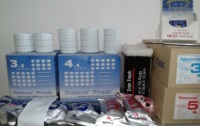|
The right plaster casting treatment prevents complications and brings to a sucessful recovery of fractures sprains and ligaments.
Although a plaster casting method is out there for quite a long time, when healing broken bones, in most cases it allows a sucessful recovery while the patient performs everyday tasks with no pain.
Plaster casting outcome:
Prevents broken bones from moving, until full recovery reaches
Stalling joints
Affixing and resting after certain operations
Helps treatments of joint ligaments
Plaster types:
Plaster Bandage
Synthetic Scoth Cast
Synthetic Soft Cast
Undercast padding fresh

Instructions for Use:
When used with synthetic casting tape, Nemoa Ever Fresh helps to keep the
skin dry and clean thanks to the excellent air permeability and water repellent
qualities. Even after a bath and shower, the water drains freely out of the cast
and the permeability allows for sweat vaporization, leaving the skin feeling dry
and refreshed.
Average drying time after shower – one and a half to two hours.
Gypsum
During the 19th century, plaster bandage is being used.
It is made of bandages rolls dipped in plaster.
When wetting the cast, it gets softer and allows a deformation.
After several minutes the cast becomes harden, while heating it.
The cast becomes dry all around whileat inside it takes up to 24
hours to dry.
After casting, it shouldn't be wet again - it breaks apart in water and it isn't benefit.
Scotch-Cast
It's made of a synthetic material and weights about 30% of the plaster cast weight.
It is waterproofed. Dipping it into water (in bath or pool) is possible.
Soft-flex-cast
It is made of two synthetic materials.
One of the materials is light, elastic and airy, which is streched around the casted limb, and the other material is haren - it affixes the damaged area only.
The soft-flex-cast is being placed on to of a thick airy stockinet, right
on the casted limb, with no cotton padding.
|